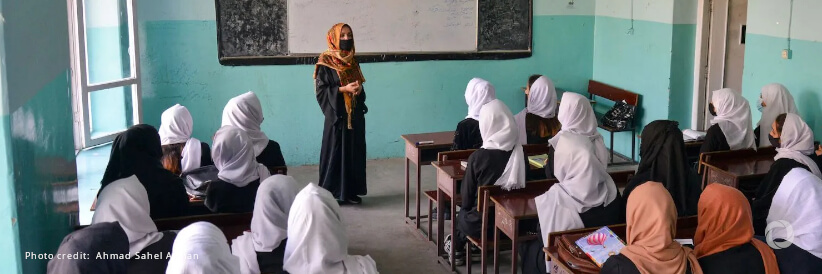Access to education has always been a major challenge for all children in Afghanistan, given the war, conflict, migration, displacement, and natural disasters that have led to the current widespread poverty and deprivation across the country.
But for girls, it has been especially hard. Nearly 30 percent of girls here have never entered primary education. 14-year-old Amina is one of them.
But community-based education is bringing change for Amina and many other girls in Afghanistan who have never had “formal” education. Last year, Amina joined CARE’s Accelerated Learning Program (ALP), which is a part of the Leave No Girls Behind (LNGB+) initiative, which launched March 21, 2021.
The project helps girls complete primary education up to grade six. LNGB+ is being implemented by a consortium of partners, including the Aga Khan Foundation, CARE Afghanistan, Catholic Relief Services, and Save the Children. ALP works with a total of 1,451 extremely marginalized out-of-school girls, including 64 girls with disabilities, and 57 ALP teachers.
Ban on girls’ education
Many schools in Afghanistan closed in August 2021, when the government officially changed hands. In the following months, schools for boys and young men gradually opened, but, while plans were there to open educational institutions for girls and women as well, that hasn’t happened.
In September 2021, the De Facto Authority suspended all forms of formal education for Afghan girls over the age of 12, leaving 1.1 million girls and young women with no access to formal education.
Then, in December 2022, university education for women was suspended until further notice, affecting over 100,000 female students attending government and private higher education institutions as well.
Since then, girls and young women over the age of 12 have been forced to stay home, waiting for schools, colleges, and universities to reopen for them. Currently, 80 percent of school-aged Afghan girls and young women – 2.5 million people — are out of school. Afghanistan is the only country in the world to put a ban on girls’ and women’s access to education, which has cost Afghanistan’s economy an estimated $5.4 billion.
Students & teachers
While Amina has never had the opportunity to study at school, she’s still been able to learn basic literacy and arithmetic through the community-based education program.
She can read and write. She says she’s lucky to have her family’s support on this journey, and, with the newly acquired skills, she has started teaching her siblings.
“What I have learned here, I teach my younger brothers and sisters at home,” she says. Despite the ongoing ban, Amina is hopeful for a brighter future. “I am very happy to be here. I want to continue my school up to grade 12. I do not want to stop there. I wish to study at the university and become a graduate,” she says. “I hope we have peace in the country, and we can have full access to school and university.”

